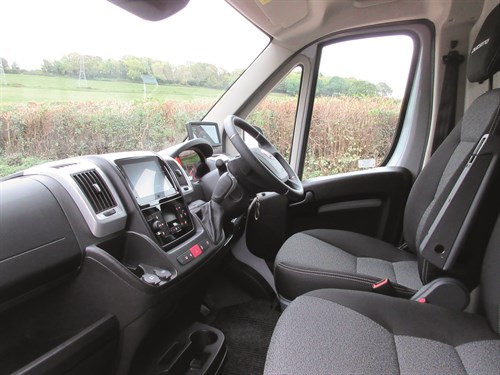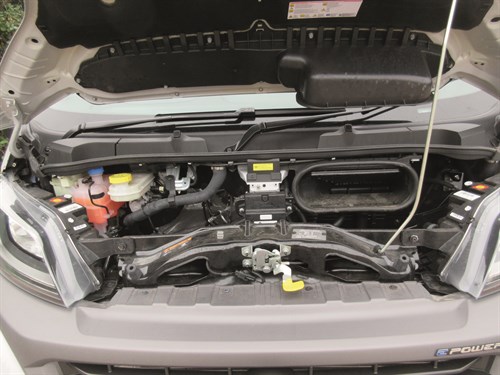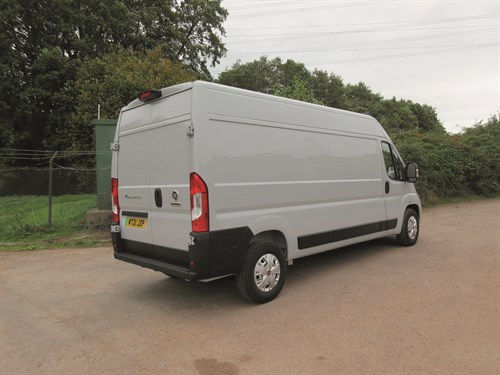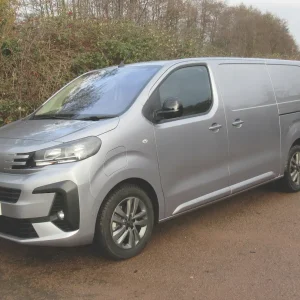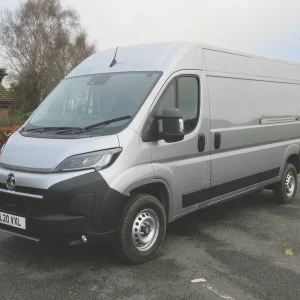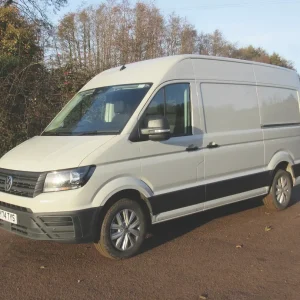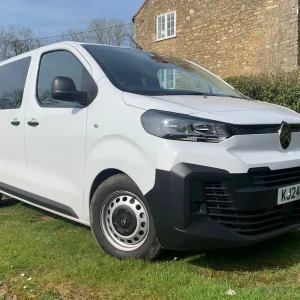Contrary to popular belief, not all prospective buyers of electric vans are kept awake at night by range anxiety.
While some want to travel as far as they possibly can before they need to plug their vehicle in to a charging point, others are perfectly happy with a range of 60 to 70 miles because that is all they ever do in a day. They would prefer to save money by specifying a smaller battery that may be quicker to charge and allow them to carry a bit more weight because it is lighter than its longer-range counterparts.
Sensible manufacturers cater for both requirements, and that is the approach Fiat Professional is pursuing with the new E-Ducato.
It can be ordered with either a three-module 47kWh or a five-module 79kWh battery, both of which are available with either an AC or a DC charging capability.
The former delivers a 139-mile WLTP (Worldwide Harmonised Light Vehicle Test Procedure) range on city work, while the latter can get up to 230 miles in an urban environment, says the manufacturer. A regenerative braking system helps replenish the battery in both cases, and both batteries feed a 90kW (122hp) motor. E-Ducato is up for grabs in van, chassis cab and passenger-carrying guise, and both batteries can be specified in all models.
Van load cubes range from 10m3 to 17m3, while payload capacities run from 690kg to 1,885kg. Gross weights are either 3,500kg or 4,250kg.
Two levels of trim are marketed – standard and eTecnico. It is worth noting that Fiat Professional has devised an app entitled Pro Fit by E-Ducato, which it says recommends the ideal E-Ducato configuration to best meet customers specific needs based on real-world usage data.
Charging times from zero to 100% are typically just under five hours for the smaller of the two batteries, rising to nearly eight hours for the bigger one using an 11kW AC on-board charger. With a 50kW DC charger, the smaller battery can be charged to 100% of its capacity in just 50 minutes, says Fiat Professional, rising to an hour and twenty minutes for its larger stable-mate.
The 11kW charger is included in the deal with the 79kWh battery and with 47kWh eTecnico models. The entry-level standard 47kWh E-Ducato comes with a 7kW charger. We got to grips with a long-wheelbase (4,035mm) high-roof van with a 13m3 load area, the 47kWh battery said to be good for a 102-mile combined WLTP range, and in eTecnico trim. Even with the government’s plug-in van grant taken into account, it carries an eye-watering £54,425 basic price tag. So is it worth it?
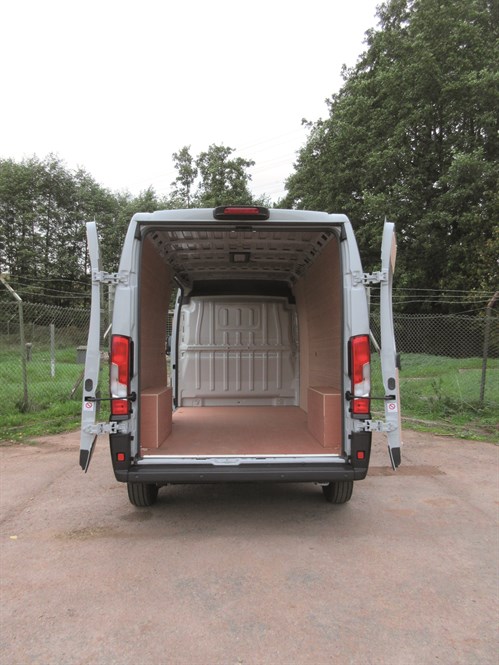
Load bay
Access to the roomy cargo area is by means of a sliding nearside door plus twin rear doors, which can be swung through 270º. A full-height steel bulkhead separates the cab from the load bay, which features LED lighting.
Strapping down wayward cargo should be easy enough thanks to the generous provision of anchorage rings.
Eight tie-down points are set into the floor with two more at the base of the bulkhead. Two are mounted at waist-height on the nearside with three more positioned at the same level on the offside.
If you are looking for somewhere to stow your tie-down straps then you can always keep them on the deep shelf above the cab accessible solely from the load area.
With a 47kWh battery, the van’s payload capacity is 1,060kg; not a lot for a 3.5-tonner. Specify a 79kWh battery and your capacity falls to a meagre 765kg.
No towing capacity is quoted; not unusual for an electric van, agreed, but a limiting factor if the nature of your business means you need to haul a trailer. Fiat Professional is hinting that this restriction may be revisited.
Interior and equipment
A dial on the dashboard tells you how much charge is left in the battery while a separate display mounted on top of the fascia repeats the information, indicates how much range remains, and shows if the regeneration function is operating. Another dial tells you how economically you are driving.
Storage space in E-Ducato’s three-seater cab includes a roomy bin in each door with a moulding, which can grasp a flask of tea or a big bottle of water. Above the bin you will find a narrow shelf, which can be used to accommodate pens and other small bits and pieces.
A small lidded glove-box sits on the passenger side of the fascia with a shelf above it, and a lidded compartment accessible from the top of the dashboard above that. Three small open shelves plus a pen tray are positioned next to it.
A moulding featuring twin cup-holders plus yet another shelf projects from the bottom of the fascia while a third cup-holder sits close to the centre of the dashboard, next to a USB port and a 12v power socket.
Flip down the centre section of the middle seat’s back and it turns into a desk complete with a couple of cup-holders, a clip to keep your paperwork tidy and a further pen tray.
A DAB radio with remote controls on the steering wheel and Bluetooth compatibility forms part of the package, and eTecnico trim wins you a 7in colour touch-screen with Apple CarPlay and Android Auto. Satnav is included with eTecnico trim as is a reversing camera (the image it displays on the dashboard screen is alas rather too small) with reverse parking sensors.
Fitted too if you opt for the higher of the two specifications are front fog lights, electrically heated and folding adjustable exterior mirrors with a wide-angle lower section, a leather-trimmed steering wheel and LED daytime running lights. Also installed are a speed limiter (E-Ducato is restricted to 62 mph to save energy) plus systems that will detect if an obstacle is in the driver’s blind spot, and issue a warning if E-Ducato is about to reverse into the path of an oncoming vehicle.
Standard on all E-Ducatos are electric windows and automatic climate control plus a plethora of safety devices.
They include Electronic Stability Control, Lane Departure Warning and Traction Control System (both of which can be switched off), Advanced Emergency Braking and Traffic Sign Recognition. A driver’s airbag is provided and our test van was equipped with an optional passenger airbag too.
What happens if things go severely wrong? Fortunately every E-Ducato comes with a 12-month subscription to Mopar Connect.
A smartphone app, it delivers support 24/7 through its crash assistance service, and allows an accident-damaged vehicle to be located quickly so that help can be despatched. The angle and height of the driver’s seat cushion can be altered and the steering wheel is reach-adjustable. An adjustable lumbar support is fitted in the back of the seat, so it should be possible for most people to find a driving position they can live with.
A deep windscreen and deep windows in the doors provide good vision ahead and to either side of the vehicle and should make it easier to spot vulnerable road users.
Independent suspension with MacPherson struts is installed at the front, while twin longitudinal leaf springs help support the rear. Our demonstrator sat on 16in steel wheels decorated with plastic trims and shod with 215/75 R16 Continental VanContact Eco tyres.
Powertrain
Delivering 280Nm of torque, E-Ducato’s electric motor is sustained by a lithium-ion battery pack that sits under the cargo bed. The charging point is next to the passenger door, beneath a flap that would normally conceal the diesel filler point.
The van comes with a mode three charging cable. If one of the battery modules drops out for any reason, then the others automatically pick up the slack so E-Ducato can continue its journey; a unique feature so far as electric light commercials are concerned, contends Fiat Professional.
Driving
You get the ball rolling by turning the key while ensuring your foot is on the brake pedal and the shift lever is in neutral position. Then you push said lever to ‘D’ for Drive if you want to go forwards, and ‘R’ for reverse if you want to go backwards.
Drivers can choose from three different driving modes by flicking a switch on the dashboard.
They are Normal (which is self-explanatory); Eco, which limits accelerator response and turns the air-conditioning off to reduce energy consumption; and Power, which delivers a bit more punch if you are tackling hilly terrain while heavily-laden.
A fourth mode – Turtle – kicks in if the battery becomes seriously depleted. The driver is warned and performance significantly reduced to extend the remaining range as far as possible.
While Eco mode may lengthen your range, it undoubtedly slows your progress even when you are lightly-laden on level terrain.
Becoming irritated by our lack of forward momentum, we switched to Normal. That meant we were making better, though not outstanding time – 122hp isn’t an enormous amount of horsepower for a van of this size – without our range suffering unduly.
What certainly affects your range is climbing steep hills, especially if you engage Power mode. We tackled several demanding inclines in Gloucestershire’s Forest of Dean and saw our projected range fall at an alarming rate.
The figure improved, however, when we turned around and went down those hills with the regeneration system engaged using the shift lever.
It started pumping juice back into the battery surprisingly rapidly while at the same time acting as a retarder, keeping our descent under control so that there was no need to touch the brake pedal. Indeed it was so effective that we occasionally had to dab the accelerator to maintain our progress, undoing some of the good work the regeneration technology had done.
Regeneration probably shows to its best advantage in stop/start urban traffic, when you are constantly lifting your foot off the gas pedal. It undoubtedly means you can travel just that little bit further between recharges, and is good news for brake life too because there is less need to rely on the service brakes in order to slow down. On the face of it replacing a diesel engine with the restrained purring of an electric motor should make the cab interior a lot quieter.
In reality however, it means that all the other sources of noise on a light commercial – the creaks from the body and the suspension, the slap of the tyres on the road surface – become much more obvious to everyone in and around the vehicle. Therefore, from the driver’s viewpoint, journeys cannot be described as silent.
E-Ducato’s ride is mediocre when lightly-laden, but improves the more weight you put in the back. Its handling is for the most part sure-footed and dependable, but somewhat spoiled by its over-assisted power steering, which needs to tighten up more at speed.
Operating
Ducato comes with what Fiat Professional describes as a 5-5-5 aftercare package embracing a five-year warranty, five years’ roadside assistance and five years’ servicing. The battery is warranted for eight years/100,000 miles, with the bigger five-module battery covered for an impressive ten years/135,000 miles.
Servicing costs are over 40% lower than those of a similar-sized diesel van reckons Fiat Professional.
A tyre repair kit is provided. Sorry, but we would rather have a proper spare wheel, despite the extra weight.
If you are going electric, then be sure to make sure you have your own charging facilities.
In reality, most publicly-accessible charging points are designed with cars in mind, and cannot comfortably accommodate a 3.5-tonner. Nor do enough of them allow you to pay for your power by using a credit card rather than being obliged to join some sort of charging club.
Fiat Professional E-Ducato 35 LWB HR 47kWh Van eTecnico
Price (ex VAT) £60,425**
Price range (ex VAT) £54,425-£75,570**
Gross payload 1,060kg
Load length 3,705mm
Load width (min/max) 1,422mm/1,870mm
Load bay height 1,932mm
Load volume 13m3
Loading height 590mm
Rear door aperture 1,562mm x 17,90mm
Side door aperture 1,250mm x 1,755mm
Gross vehicle weight 3,500kg
Residual value TBA
Cost per mile TBA
Engine size/power 90kW (122hp) electric motor
Torque 280Nm
Gearbox 1sp
Range 102 mls (WLTP combined)
Battery 47kWh
Warranty 5yrs/100,000 miles (battery – 8yrs/100,000 miles)
Service intervals 2yrs/36,000 miles
Insurance group TBA
Price as tested £60,655**
** Basic price before Plug-In Van Grant calculations
Options
Passenger airbag £230
Rivals
Maxus eDeliver 9
Price (ex VAT) From £55,000**
Load volume 9.7-11m3
Gross payload 860-1200kg
Electric motor 150kW
Verdict: Having dropped the LDV name in favour of Maxus, the Chinese manufacturer is importing a newly-introduced electric light commercial with a range of up to 219 miles depending on the version you select. Not short of power, the Maxus eDeliver 9 is well worth investigating.
Mercedes-Benz eSprinter
Price (ex VAT): £53,510-£54,050**
Load volume: 11m3
Gross payload: 731kg
Electric motor: 85kW
Verdict: Limited line-up, and at just shy of 96mls the maximum range between recharges cannot be classed as outstanding; and eSprinter relies on a 50mph speed limiter to achieve it. Specify an 80kW DC charger though and you can restore your battery to 80% of its capacity in half-an-hour says Mercedes.
Renault Master Van Z.E.
Price (ex VAT) £54,900-£61,800**
Load volume 8-13m3
Gross payload 925-1425kg
Electric motor 57kW
Verdict: Broad spread of models with a decent payload capability, but at 75mls, the range between recharges is limited – not an issue for all businesses, admittedly – and on-highway performance is not exactly overwhelming. Bear in mind that the same model is marketed by Renault Trucks; worth talking to if you have specialist conversion requirements.
The Final Verdict
Design 8/10 – Offering a choice of battery packs and ranges makes sound sense
Cabin 8/10 – Comfortable and well-equipped working environment that is unlikely to disappoint
Ride 6/10 – Choppy when E-Ducato is lightly-laden, but improves with some weight in the back
Refinement 6/10 – Absence of decibels from a diesel engine means other noises are highlighted
Load area 8/10 – Roomy, easy to access, and with plenty of load tie-down points
Handling/performance 6/10 – Over-assisted power steering – would benefit from a few more horses
Engine/transmission 8/10 – Power is delivered smoothly, with all the torque available instantly
Standard equipment 8/10 – Plenty of kit if you opt for eTecnico trim
Operating costs 9/10 – Impressive aftersales package and low maintenance
What Van? subjective rating 8/10 – Front-end price is painfully steep but competitive running costs keep price down
Overall Rating = 75/100

